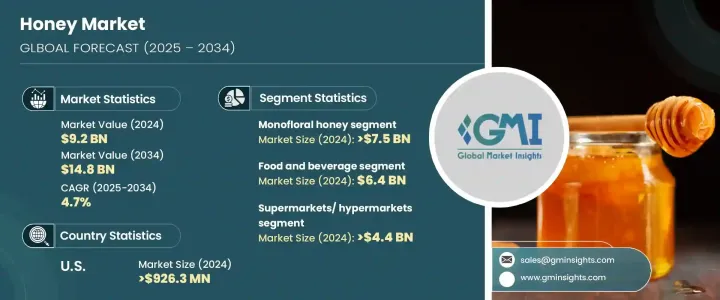
세계의 벌꿀 시장은 2024년에 92억 달러로 평가되었으며, 2025년부터 2034년에 걸쳐 CAGR 4.7%로 성장할 것으로 예측되고 있습니다.
이러한 성장은 주로 천연 감미료로 전환하는 소비자의 증가에 의해 주도되고 있습니다. 가공 설탕을 멀리하는 사람들이 늘어나면서 천연 성분과 건강상의 이점으로 인해 꿀이 선호되는 대안으로 떠오르고 있습니다. 이러한 추세는 최소한의 가공을 거치고 인공 첨가물이 없는 식품인 클린 라벨 제품에 대한 소비자 수요가 증가함에 따라 더욱 가속화되고 있습니다. 천연의 건강한 식재료라는 꿀의 명성은 건강을 중시하는 현대인의 선택과 점점 더 일치하고 있습니다. 또한 지속 가능하고 윤리적인 식품 생산의 이점에 대한 인식이 높아지면서 꿀, 특히 생꿀과 유기농 꿀이 요리계와 웰빙 업계에서 인기를 얻고 있습니다. 이러한 소비자 선호도의 역동적인 변화는 향후 몇 년 동안 꿀에 대한 수요를 계속 가속화할 것으로 예상됩니다.

벌꿀 시장의 모노플로럴 부문은 2024년에 75억 달러를 차지하며, 2025년부터 2034년까지 연평균 성장률(CAGR) 4.6%로 성장할 전망입니다. 단일 꽃 품종의 꿀에서 추출한 모노플로랄 꿀은 독특한 풍미와 강력한 건강상의 이점으로 인해 프리미엄 꿀로 자리매김했습니다. 소비자들은 이러한 유형의 벌꿀의 순도와 특정 꽃과 관련된 치료 효과로 인해 이러한 유형의 벌꿀을 선호합니다. 고품질 특수 식품에 대한 수요가 증가함에 따라 단일 꽃 꿀은 국내 및 글로벌 시장에서 점점 더 최고급 제품으로 인식되고 있습니다. 독특한 맛과 자연 요법을 찾는 사람들 사이에서 인기가 높아지면서 광범위한 벌꿀 산업에서 독보적인 위치를 차지하고 있습니다.
| 시장 범위 | |
|---|---|
| 시작 연도 | 2024년 |
| 예측 연도 | 2025-2034년 |
| 시작 금액 | 92억 달러 |
| 예측 금액 | 148억 달러 |
| CAGR | 4.7% |
용도별로는 식음료 부문이 2024년 64억 달러의 매출을 기록하며 선두를 달리고 있습니다. 천연 감미료인 꿀의 다용도성 덕분에 제빵, 음료, 스낵, 과자 등 여러 식품 카테고리에서 꿀은 필수 불가결한 존재가 되었습니다. 특히 건강에 민감한 소비자를 대상으로 하는 제품에서 정제 설탕을 대체할 수 있는 건강한 감미료로 꿀의 사용이 크게 증가하고 있습니다. 시장이 계속해서 깨끗한 천연 재료를 우선시함에 따라 다양한 식품 제형에서 꿀의 역할이 커질 것으로 예상되며, 이 부문은 2025년부터 2034년까지 연평균 복합 성장률(CAGR) 4.5%로 확대될 것으로 예측되고 있습니다.
미국의 벌꿀 시장은 2024년에 9억 2,630만 달러로 평가되었으며, 2034년까지의 CAGR은 5%를 보일 전망입니다. 천연 감미료에 대한 수요가 급증하고 건강한 식품에 대한 선호도가 높아진 것이 이러한 증가에 기여했습니다. 미국 시장은 광범위한 유통망의 혜택을 받아 슈퍼마켓, 건강식품점, 온라인 플랫폼에서 꿀을 쉽게 구할 수 있습니다. 유기농 및 생꿀 품종을 선택하는 소비자가 늘어남에 따라 이러한 탄탄한 인프라는 고품질 제품에 대한 광범위한 접근을 지원합니다.
The Global Honey Market was valued at USD 9.2 billion in 2024 and is projected to experience steady growth, expanding at a CAGR of 4.7% between 2025 and 2034. This growth is primarily driven by an increasing consumer shift toward natural sweeteners. As more people move away from processed sugars, honey is emerging as a preferred alternative due to its natural composition and health benefits. This trend is further fueled by a growing consumer demand for clean-label products-foods that are minimally processed and free from artificial additives. Honey's reputation as a natural, wholesome ingredient is increasingly aligning with modern health-conscious choices. In addition, as awareness around the benefits of sustainable and ethical food production grows, honey, particularly raw and organic varieties, is gaining popularity in both culinary and wellness circles. This dynamic shift in consumer preferences is expected to continue to accelerate the demand for honey in the coming years.

The monofloral segment of the honey market accounted for USD 7.5 billion in 2024 and is set to grow at a CAGR of 4.6% from 2025 to 2034. Monofloral honey, derived from the nectar of a single flower variety, has established itself as a premium choice due to its distinctive flavor profiles and potent health benefits. Consumers favor this type of honey for its purity and the therapeutic effects linked to the specific flowers from which it is sourced. As the demand for high-quality specialty foods rises, monofloral honey is increasingly seen as a top-tier product in both the domestic and global markets. Its growing popularity among those seeking unique tastes and natural remedies positions it as a standout within the broader honey industry.
| Market Scope | |
|---|---|
| Start Year | 2024 |
| Forecast Year | 2025-2034 |
| Start Value | $9.2 Billion |
| Forecast Value | $14.8 Billion |
| CAGR | 4.7% |
In terms of application, the food and beverage sector leads, generating USD 6.4 billion in 2024. Honey's versatility as a natural sweetener has made it indispensable across multiple food categories, including baked goods, beverages, snacks, and sweets. Its use as a healthier substitute for refined sugars has grown significantly, especially in products targeting health-conscious consumers. As the market continues to prioritize clean, natural ingredients, honey's role in various food formulations is expected to grow, with this segment projected to expand at a CAGR of 4.5% from 2025 to 2034.
The U.S. honey market alone reached USD 926.3 million in 2024, with expectations for a 5% CAGR through 2034. The surge in demand for natural sweeteners and the growing preference for healthier food choices have contributed to this increase. The U.S. market benefits from an extensive distribution network, making honey readily available in supermarkets, health food stores, and online platforms. As more consumers choose organic and raw honey varieties, this robust infrastructure supports widespread access to high-quality products.